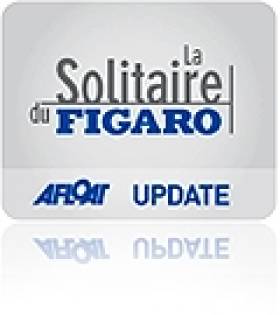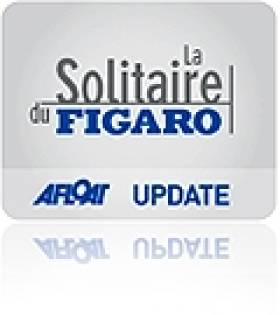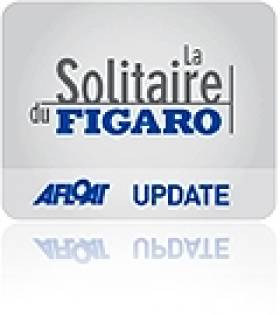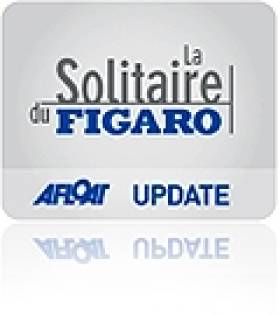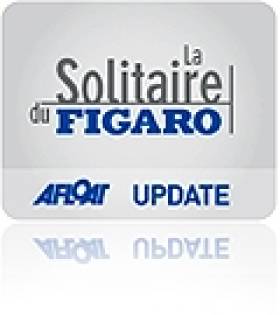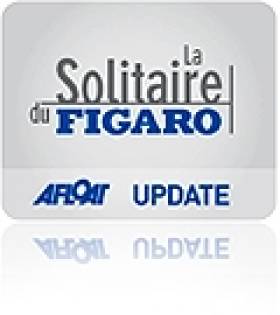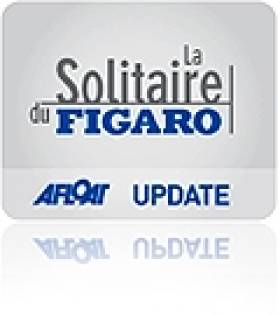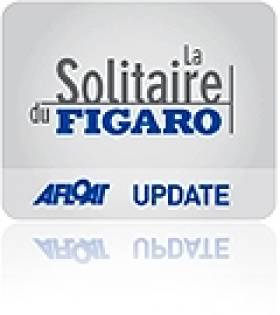Displaying items by tag: La Solitaire du Figaro
Plymouth Wins Figaro Stop, No Irish Port in 2014 French Grand Prix Event
#figaro – The French La Solitaire du Figaro race will visit Plymouth for the first time in June dashing hopes that the race might return to Ireland.
In spite of an innovative new course including a departure from Bordeaux and a Portuguese stage there will be no Irish leg of the 45th edition of the race and instead the race calls to Britain for the first time in its history.
This year Irish youngster David Kenefick won the Rookie of the year prize and there were hopes that his intended continuation in the circuit might bring the race to Ireland as it previously did in 2012.
The 2,014-mile race is one of the main training grounds for the Vendee Globe race, and this will be the first time it has included a British leg.
Sutton Harbour will host some 45 of the world's top sailors, including local sailor Sam Goodchild. The 24-year-old achieved the best British result since 1975, finishing in 11th place this year.
Around 45 sailors, all on identical 33ft boats will arrive in Sutton Harbour at the end of Leg 1 on Wednesday, June 11.
Spectators will see close-fought inshore racing in Plymouth Sound before the fleets departs on its second leg on Saturday, June 14.
The stopovers were announced at the official Solitaire launch in Paris on Thursday.
More than 30,000 visitors are expected to be lured to Plymouth next summer when the city hosts one of sailing's grand prix events.
David Kenefick, Youngest Irish Skipper, Finishes Figaro
#figaro – David Kenefick finished the fourth and final leg of the 2013 Solitaire Figaro in Dieppe in the small hours of this morning. Forty-one skippers started this solo race and 2000 miles over the four legs visiting three countries. The Figaro is scored on cumulative elapsed time over all four legs. For the second year in a row the race has been won by Yann Elies. Xavier Macaire was second 25 minutes behind, and in third place was Morgan Lagraviere a further seven minutes back. David finished the race in 28th place, some 12 hours and 14 minutes behind the leader and third of the seven Rookies. This last leg was without question the hardest with strong winds for the last 36 hours seeing one complete dismasting and five other retirements.
Now in its 44th year and following Damian Foxall, Marcus Hutchinson and Paul O'Riain, 22–year–old David has become the fourth and youngest-ever Irish skipper to finish this legendary race.
Shortly after finishing in Dieppe David had the following things to say in a bleary, punch drunk state of fatigue:
On Leg 4. "This leg was really good. It had a lot that we hadn't in the previous legs. Unfortunately, I found myself struggling for speed, which I've done all month. I have crawled my way back into it. It was hard but great."
"I started crawling back into it at Ushant. We had to go rock hopping in the dark and in the mist. My laptop was not working at the time. I had to use my iPad to navigate between a few rocks. That was the scariest part of the race for me, sailing between rocks and hearing breaking water all around me, with almost zero visibility."
On gaining 10-11 places overnight on Friday. "From Wolf Rock to Needles Fairway buoy last night was pretty amazing. I set the small kite with one reef – it was crazy. I was just waiting for something to break. I knew that I'd break myself before the boat broke as so many people have told me. These boats are tough, fast and amazingly stable to sail downwind in a big breeze. I was waiting for the rig to break, but it stayed up. I hoisted at 0200 and just drove all night long. The boat was underneath the water the whole time. I've never done anything like that before, fully powered up all night long. I was terrified that I was going to lose control, and I certainly didn't trust the pilot to do a better job. But next time we got the rankings on the VHF I had gained a lot of places. Through hard work comes gain!!! The most wind I saw on this leg was 38 knots. But sometimes you couldn't see the instruments, and sometimes you didn't want to see them!!!"
On broaching and losing it. "A few times I lost control. But I just let the kicker go, bore off and she was away again. Having two rudders is a joy. It makes it so much easier to push hard safely. I was one of the first to hoist after Wolf Rock in the bunch I was with. I hoisted the moment I'd cleared the Wolf Rock and with it I gained 11 places. Coming into the Needles, we had about 30 knots but then the breeze died and re-built up to 30 knots and unfortunately I did a violent Chinese gybe."
"The strop on my boom that holds the mainsheet on snapped. I managed to gybe back, but my mainsail was lose. I knew I had to drop the kite at the same time to be in a position to safely fix the mainsheet back onto the boom. I dropped the kite but then the kite went flying back out of the hatch. Then my jib sheets came out of the blocks, no figure of eight, so I was trying to chase three sails at the same time!!!!
That was coming into the Needles. I got the two spinnaker sheets and tied those around the boom like on a Superyacht. I made up a new strop for the boom because I knew I'd need the spinnaker sheets again later. Eventually, everything was back under control."
On overall feelings about the Figaro Race. "It was an amazing leg and the whole month has been amazing. If you had said to me last year that I'd be at the finish of the Solitaire, I don't think I would have believed you."
On what's next. "Part of me is now hooked on this race but part of me is a bit frustrated. Unfortunately, the mind has a tendency to forget the hard parts. I'll wait a few weeks and see what I think about it. I am a bit upset. I thought I'd enjoy it a bit more. I have had a difficult month. The night before the start in Bordeaux we had to change the forestay as we found a crack. I'm glad we did. Two forestays have failed in this race, and three rigs have failed. I have had no technical issues at all other than wear and tear and my computer going down from time to time. But this is a sailboat and if you can't sail without a computer you shouldn't be out there. With everything that I have learnt over the last month and the experience I have gained I'd love to be starting this race tomorrow. I'm ready to be a rookie now, but I'm no longer a first timer!"
#fullrish – Well Leg 3 didn't go as well as David Kenefick would have liked. He has had a tendancy to treat 200-mile long legs like the first beat of a windward leeward and want to immediately tack to clear his air if he is in dirty air. The problem is that that usually means leaving the fleet and even compromising the side of the course that you want to be on which in a boat speed race, which the Figaro often is, means losing valuable distance and then being on the back foot for the rest of the race.
Leg 3 from Gijon to Roscoff was to be sailed in two parts, the first a 200-mile section across the bay of Biscay to round the Island of Yeu off the Vendée coast, and the second another 240 miles up the French coast through the Raz de Sein around the tip of Brittany and along to Roscoff.
The first part was sailed under a complex ridge of high pressure straddling the whole Bay and the second in the influence of the South Westerly winds to the North of the ridge and an approaching front and depression. The ridge should have been slow and tedious to cross with long periods of light and no wind with skippers watching their barometers to know whether they were to the North or South of the ridge axis. In fact it all turned out differently and the switch from SE to W winds came very quickly and with more pressure the race stayed quick all the way to the finish.
On the wrong side of the fleet David suffered and then had to hang in there knowing that there were going to be no strategic opportunities later and that it would be all about speed and staying awake to drive the boat hard in the freshening conditions. To cut a long story short David finished early on Sunday morning in Roscoff quite far down the rankings and about 6 hours behind the leg winner Morgan Lagraviere. However, other Rookies also had a tough time and one of the favourites Claire Pruvot had to retire from the leg with a broken spreader. The time penalty means that David has moved up a place to third place amongst the seven first timers, and hour and ten minutes off second place and four and a quarter hours off the lead.
The fleet has had four days in Roscoff, a fascinating new port has been built here recently and as we normally just get off the ferry and head for the motorway when passing through we have all had the chance to discover this enchanting small town and the environs. David's partner in this adventure the Comptoir Irlandais, held a drinks reception for him and their guests on Tuesday night in the race village and hopefully the relationship that is being built will lead to further adventures later this year and next. This is after all a commercial proposition and David's success and his boat's coverage here with its Comptoir Irlandais branding on it is promoting the sale of Irish products in the company's 42 shops the length and breadth of the country.
So enough of Leg 3 now its time for the fourth and final leg of this year's race. Roscoff, outside Ushant, via the Chausee de Sein, through the Chenal du Four and up to Wolf Rock, along the South Coast of England to the Needles Fairway, across to a buoy off the port of Antifer near Le Havre and then up the coast to Dieppe and the finish. Five hundred and twenty miles of coastal, cross-channel, tidal, rockhopping and weather driven racing lies ahead. The start is Thursday at 13:00 local and will be in a medium North Westerly breeze. The North Brittany coast is rocky and when the tide is against, you need to get in amongst them to find some shelter and when the tide turns find it inshore first. Outside Ushant and downwind to the navigation mark at the Western extremity of the Sein archipelago will be highly boatspeed dependent. The return North through the Chanel du Four will again be hugely dependent on the state of the tide and again the chances are that the rich will get richer as the leaders get through before the tide turns foul for the followers.
The leg North from here to the Wolf Rock off the Cornish coast is probably going to be upwind and will sort out the men and women from the boys and girls. What's more there is the chance of a tidal gate here with the east going flood tide heading up the Channel ready to whisk away the leaders and give them another advantage. The wind should be piping up strongly at this stage on Friday evening and the fleet will be set for some high speed downwind sailing overnight and into Saturday as the legendary headlands of The Lizard, Start Point, Portland Bill and Anvil Point are ticked off. The Needles Fairway buoy will be a right turn for the fleet into a freshening SSW breeze meaning a wet 100-mile jib reach slog back to the French side of the Channel and a landfall buoy off the oil tanker harbour of Antifer near Le Havre. The final 50-odd miles will again see spinnakers blossom and a high speed chase continue to the conclusion of this year's event.
There isn't much upwind sailing, there are several tidal gates, it will be fresh for at least half of the course and there wont be too many opportunities to sleep. This will be physically the toughest of the four legs of this year's race and we expect to see the leaders finishing in Dieppe in the small hours of Sunday morning. Spare a thought for them all over the next few days!!!
#fullirish – Royal Cork's David Kenefick was 18th in the second leg of the Figaro Race that concluded this morning. Overall this puts the sole Irish sailor 30th overall in the 41-boat professional fleet. Full results breakdown below.
Vendée Globe competitor and two time Solitaire winner Armel Le Cleac'h takes home the Leg 2 win, with second skipper Morgan Lagraviere just 59 seconds behind. Light and unpredictable conditions made for an incredibly close end to the Leg – after 298 miles of racing, the first 15 boats finished within one hour of the winner Armel.
Four British skippers finish within the top 20 boats – Sam Goodchild maintains the best of British title, finishing 11th after Leg 2 and Academy Rookie Jack Bouttell delivers another sterling performance as third Rookie to hold on to his overall lead by five minutes in the Rookie division,
On the evening of Monday 10th June, the short and tactical 298-mile Leg 2 of the Solitaire du Figaro, from Porto (Portugal) to Gijon (Spain) concluded. After a final close contact drag race to the finish line, at 15:21:43 BST Armel Le Cleac'h won Leg 2 of the Solitaire du Figaro, with Morgan Lagraviere crossing the line in second just 59 seconds behind him and the next 13 skippers finishing within an hour of the two leaders after just over 51 hours of racing. Leg 2 of the 1,938 mile race saw mixed results for the Artemis Offshore Academy, with a delighted Sam Goodchild (Shelterbox-Disaster Relief) finishing the race in 11th, Nick Cherry (Magma Structures) in 14th, Jack Bouttell (Artemis 77) in 19th and third Rookie and Henry Bomby (RockFish) in 20th to see four British skippers inside the top 20, followed by a very disappointed Ed Hill in 38th. For current leading British skipper Sam, his cumulative times for leg 1 and 2 put the 23-year-old 9th in the overall Solitaire du Figaro rankings.
"I feel much happier with this Leg," said a chuffed Sam on the dock, finishing the Leg after 2 days, 3 hours, 42 minutes and 12 seconds at sea. "Even though I finished 8th after Leg 1, I feel that on this Leg I sailed myself into 11th as opposed to getting lucky and ending up in the top 10, so I'm much happier with that result."
After leaving Porto, the light and wholly unpredictable winds off the Spanish Coast soon left weather reports redundant, with the skippers instead having to take each shift as it came, adding to the frustration and tactical nature of the Leg: "I finished Leg 2 with another good result, but I never knew what was going on with the wind," reported Magma Structures skipper Nick after finishing Leg 2 in 14th. "From a few hours into the race I decided to just throw the weather forecast out of the window, as nothing was playing out as it should have, so I just tried to stay with the middle of the fleet, sometimes dropping back, sometimes moving forward, but managing to finish just at the right time." See Nick's post race interview here.
"It was very difficult to know what the wind was doing, I had no idea most of the time," Jack added. "I was trying to take into account what Nico (Coach) had told us, but it played out very differently, so it was a bit of luck, and making the most of stable winds to sleep. It was a tricky Leg, standard Figaro and very frustrating." Jack was the third British skipper to finish in Gijon in 19th, also claiming third in the Rookie class just six minutes and six seconds behind winning Rookie Claire Pruvot, with Jack keeping hold of his overall Solitaire du Figaro Rookie division lead by just over five minutes. See Jack's post race interview and onboard footage here.
After a poor start and hanging on in the thirties for the first half of the race, Academy Graduate Henry pulled it out of the bag to climb 13 places over the final day of racing to finish 20th, making Henry the fourth Brit to finish within the top 20 boats at the end of Leg 2: "I made some silly mistakes in my in navigation and I lost a lot of time on that, but this is still my best result in the Solitaire so I'm not too unhappy, just frustrated because I know I could have done a lot better and didn't." Despite claiming his best Solitaire du Figaro result to date, at the end of Leg two the RockFish skipper was faced with bad news after finishing last behind Sam Goodchild, Alexis Loison, Fabien Delahaye and Claire Pruvot – his housemates: "I think I'm the last in the house and for the second time Claire beat me. We did a little internal competition and I think next year, it's going to be me who'll be doing the dishes..."
Ed was the final Academy skipper to arrive back on the docks at 09:33BST as Leg 2 turned into a nightmare for this aspiring skipper. After taking a risky turn west in search of breeze on the approach to Cape Finisterre, Ed was left chasing the fleet before managing to climb three places to finish 38th in the final hours of racing: "I ended up sailing 6 miles behind everyone else and on my own for two days, which was pretty horrible. Fortunately, I caught up with the guys at the back but it's still a terrible result. I'm pretty gutted. I wanted to not lose the Solitaire in a Leg and that is what's happened, meaning all of my hopes of doing well as a Rookie have been dashed." Ed's combined results from Leg 1 and 2 leave him 34th overall with two Legs left to sail. He will now have to find the motivation for the remaining two legs, and perhaps with the pressure off Ed will sail more freely but it is an experience that will, undoubtedly, knock his confidence and demonstrates what a cruel mistress the Solitaire can be. See Ed's dockside interview here.
With two Legs down, Sam is still in the running to win the Patton Hark Regatta Watch as part of the Patton Challenge, despite some pre-race fighting talk from his rivals: "I'm in second behind Sam, but there's four boats behind who'll be keen to win the watch off me," boasted Nick. "I definitely want to win it, it's a good prize and I want to beat the other guys for sure."
Follow the progress of Nick, Sam, Ed, Jack and Henry during the Solitaire du Figaro and Patton Challenge via the Artemis Offshore Academy website. Keep up to date with the latest Solitaire du Figaro news via Facebook and Twitter.
The Patton Challenge Rankings after Leg 1 and 2
Position/Skipper/Boat name/Leg 1/Leg 2/Total points
1. Sam Goodchild/Shelterbox-Disaster Relief/1/1/2
2. Nick Cherry/Magma Structures/2/2/4
3. Jack Bouttell/Artemis 77/3/4/7
4. David Kenefick/Full Irish/6/3/9
5. Ed Hill/Artemis 37/4/6/10
6.Henry Bomby/5/5/10
Solitaire du Figaro Leg 2 results:
Position/Skipper/Boat name/Time at sea
1. Armel Le Cleac'h/BANQUE POPULAIRE/2d, 3h, 11', 43"
2. Morgan Lagraviere/VENDEE/2d, 3h, 12', 42"
3. Anthony Marchand/BRETAGNE CREDIT MUTUAL PERFORMANCE/2d, 3h, 16', 12"
4. Jeremie Beyou/MAITRE COQ/2d, 3h, 16', 56"
5. Yann Elies/GROUPS QUEGUINER – LEUKEMIA HOPE/2d, 3h, 19', 45'
6. Yoann Richmomme/DLBC/2d, 3h, 23', 29"
7. Damien Guillou/SOLIDARITY MUTUALISTE/2d, 3h, 27', 5"
8. Nicolas Lunven/GENERALI/2d, 3h, 28", 41"
9. Fabien Delahaye/SKIPPER MACIF 2012/2d, 3h, 30', 32"
10. Frédéric Duthil/SEPULMIC/2d, 3h, 32', 47"
11. Sam Goodchild/SHELTERBOX – DISASTER RELIEF/2d, 3h, 42', 12"
12. Paul Meilhat/SKIPPER MACIF 2011/2d, 3h, 43', 34"
13. Michel Desjoyeaux/TBS/2d, 3h, 43', 43"
14. Nick Cherry/MAGMA STRUCTURES/2d, 3h, 45', 36"
15. Alexis Loison/FIVA GROUPS/2d, 3h, 46', 10"
16. Claire Pruvot/PORT DE CAEN OUISTREHAM/2d, 4h, 2', 30" – 1st Rookie
17. Xavier Macaire/SKIPPER L'HERAULT/2d, 4h, 4', 33"
18. David Kenefick/FULL IRISH/2d, 4h, 7', 53"/Rookie
19. Jack Bouttell/ARTEMIS 77/2d, 4h, 8', 24"/Rookie
20. Henry Bomby/ROCKFISH/2d, 4h, 29' 50"
21. Corentin Horeau/BRETAGNE CREDIT MUTUEL ESPOIR/2d, 4h, 30', 52"
22. Matthieu Girolet/LAFONT PRESSSE/2d, 4h, 32', 45"
23. Benoit Hochart/ADOCIS/IB REMARKETING/2d, 4h, 41', 6"/Rookie
24. Jean Paul Mouren/GROUPE SNEF/2d, 4h, 54', 21"
25. Jean-Pierre Nicol/BERNARD CONTROLS/2d, 4h, 58', 6"
26. Thierry Chabagny/GEDIMAT/2d, 5h, 3', 25"
27. Gildas Morvan/Cercle Vert/2d, 5h, 16', 48"
28. Nicolas Jossier/IN EXTENSO ACCOUNTANTS/2d, 5h, 25', 22"
29. Adrien Hardy/AGIR RECOUVREMENT/2d, 5h, 34', 42"
30. Julien Villion/SEXIO HABITAT/2d, 5h, 35', 38"
31. Thomas Ruyant/DESTINATION DUNKERQUE/2d, 5h, 39', 30"
32. Frédéric Rivet/DFDS SEAWAYS/2d, 6h, 11', 36"
33. Simon Troel/LES RECYCLEURS BRETONS/2d, 6h, 16', 27"/Rookie
34. Vincent Biarnes/PRATIBUCHES/2d, 6h, 19', 24"
35. Yannig Livory/THERMACOTE FRANCE/2d, 6h, 27', 15"36. Gilles Le Baud/CARNAC THALASSO & SPA/2d, 9h, 0', 35"
37. Joan Ahrweliller/REGION BASSE NORMANDIE/2d, 9h, 7', 19"/Rookie
38. Ed Hill/ARTEMIS 37/ 2d, 9h, 23', 27"/Rookie
39. Didier Bouillard/JEHOL/2d, 9h, 30', 16"
40. Amaiur Alfaro/REGION AQUITAINE/ATELIERS DE FRANCE/2d, 9h, 35', 45"
41. Louis Maurice Tannyéres/JOANNA/RTR
Solitaire du Figaro rankings overall after Legs 1 and 2:
Position/Skipper/Boatname/Leg 1 time/Leg 2 time/Accumulative time/Time behind leader
1. Yann Elies/GROUPE QUEGUINER – LEUCEMIE ESPOIR/3 days, 3h 3m 26s/2 days, 3h 19m 45s/5 days, 6h 23m 11s
2. Frédéric Duthil/SEPALUMIC/3 days, 3h 47m 30s/2 days, 3h 32m 47s/5 days, 7h 20m 17s/0h 57m 06s
3. Alexis Loison/FIVA GROUPS/3 days, 4h 21m 2s/2 days, 3h 46m 10s/5 days, 8h 7m 12s/1h 44m 01
4. Xavier Macaire/SKIPPER L'HERAULT/3 days, 4h 8m 38s/2 days, 4h 4m 33s/5 days, 8h 13m 11s/1h 50m 00s
5. Morgan Lagravière/VENDEE/3 days, 5h 4m 5s/2 days, 3h 12m 42s/5 days, 8h 16m 47s/1h 53m 36s
6. Armel Le Cléac'h/BANQUE POPULAIRE/3 days, 5h 8m 48s/2 days, 3h 11m 43s/5 days, 8h 20m 31s/1h 57m 20s
7. Yoann Richomme/DLBC/3 days, 4h 59m 35s/2 days, 3h 23m 29s/5 days, 8h 23m 4s/1h 59m 53s
8. Jeremiah Beyou/MAITRE COQK/3 days, 5h 10m 4s/2 days, 3h 16m 56s/5 days, 8h 27m 0s/2h 03m 49s
9. Sam Goodchild/ShelterBox – DISASTER RELIEF/3 days, 4h 49m 29s/2 days, 3h 42m 12s/5 days, 8h 31m 41s/2h 08m 30s
10. Nicolas Lunven/GENERALI/3 days, 5h 3m 3s/2 days, 3h 28m 41s/5 days, 8h 31m 44s/2h 08m 33s
11. Paul Meilhat/SKIPPER MACIF 2011/3 days, 4h 54m 32s/2 days, 3h 43m 34s/5 days, 8h 38m 6s/2h 14m 55s
12. Damien Guillou/SLA SOLIDARITÉ MUTUALISTEE/3 days, 5h 13m 28s/2 days, 3h 27m 5s/5 days, 8h 40m 33s/2h 17m 22s
13. Fabien Delahaye/SKIPPER MACIF 2012/3 days, 5h 13m 42s/2 days, 3h 30m 32s/5 days, 8h 44m 14s/2h 21m 03s
14. Nick Cherry/MAGMA STRUCTURES/3 days, 5h 0m 34s/2 days, 3h 45m 36s/5 days, 8h 46m 10s/2h 22m 59s
15. Jean-Pierre Nicol/BERNARD CONTROLS/3 days, 3h 59m 44s/2 days, 4h 58m 6s/5 days, 8h 57m 50s/2h 34m 39s
16. Michel Desjoyeaux/TBS/3 days, 5h 24m 32s/2 days, 3h 43m 43s/5 days, 9h 8m 15s/2h 45m 04s
17. Thierry Chabagny/GEDIMAT/3 days, 4h 27m 46s 2 days/5h 3m 25s/5 days, 9h 31m 11s/3h 08m 00s
18. Jackson Bouttell/ARTEMIS 77/3 days, 5h 27m 49s/2 days, 4h 8m 24s/5 days, 9h 36m 13s/3h 13m 02s/1ST Rookie
19. Claire Pruvot/PORT DE CAEN Ouistreham/3 days, 5h 38m 45s/2 days, 4h 2m 30s/5 days, 9h 41m 15s/3h 18m 04s/Rookie
20. Gildas Morvan/CERCLE VERT/3 days, 4h 26m 6s/2 days, 5h 16m 48s/5 days, 9h 42m 54s/3h 19m 43s
21. Anthony Marchand/BRETAGNE CRÉDIT MUTUEL PERFORMANCE/3 days, 6h 30m 3s/2 days, 3h 16m 12s/5 days, 9h 46m 15s/3h 23m 04s
22. Matthew Girolet/LAFONT RELEASE/3 days, 6h 5m 3s/2 days, 4h 32m 45s/5 days, 10h 37m 48s/4h 14m 37s
23. Nicolas Jossier/IN EXTENSO experts comptables/3 days, 5h 13m 11s/2 days, 5h 25m 22s/5 days, 10h 38m 33s/4h 15m 22s
24. Henry Bomby/ROCKFISH/3 days, 6h 14m 7s/2 days, 4h 29m 50s/5 days, 10h 43m 57s/4h 20m 46s
25. Adrien Hardy/Thomas Ruyant/3 days, 5h 27m 6s/2 days, 5h 34m 42s/5 days, 11h 1m 48s/4h 38m 37s
26. Benedict Hochart/ADOCIS / IB Remarketing/3 days, 6h 25m 8s/2 days, 4h 41m 6s/5 days, 11h 6m 14s/4h 43m 03s/Rookie
27. Frédéric Rivet/DFDS SEAWAYS/3 days, 5h 6m 23s/2 days, 6h 11m 36s/5 days, 11h 17m 59s/4h 54m 48s
28. Thomas RuyanT/DESTINATION DUNKERQUE/3 days, 5h 41m 32s/2 days, 5h 39m 30s/5 days, 11h 21m 2s/4h 57m 51s
29. Vincent Biarnes/PRATI'BÛCHES/3 days, 5h 6m 38s/2 days, 6h 19m 24s/5 days, 11h 26m 2s/5h 02m 51s
30. David Kenefick/FULL IRISH/3 days, 7h 30m 55s/2 days, 4h 7m 53s/5 days, 11h 38m 48s/5h 15m 37s/Rookie
31. Corentin Horeau/BRETAGNE – CRÉDIT MUTUEL ESPOIR/3 days, 7h 9m 17s/2 days, 4h 30m 52s/5 days, 11h 40m 9s/5h 16m 58s
32. Julien Villion/SEIXO HABITAT/3 days, 7h 33m 33s/2 days, 5h 35m 38s/5 days, 13h 9m 11s/6h 46m 00s
33. Yannig Livory/THERMACOTE FRANCE/3 days, 7h 23m 21s/2 days, 6h 27m 15s/5 days, 13h 50m 36s/7h 27m 25s
34. Edmund Hill/ARTEMIS 37/3 days, 6h 9m 17s/2 days, 9h 23m 27s/5 days, 15h 32m 44s/9h 09m 33s/Rookie
35. Didier Bouillard/JEHOL/3 days, 7h 55m 2s/2 days, 9h 30m 16s/5 days, 17h 25m 18s/11h 02m 07s
36. Simon Troel/LES RECYCLEURS BRETONS/3 days, 11h 25m 52s/2 days, 6h 16m 27s/5 days, 17h 42m 19s/11h 19m 08s/Rookie
37. Joan Ahrweiller/REGION BASSE NORMANDIE/3 days, 8h 51m 33s/2 days, 9h 7m 19s/5 days, 17h 58m 52s/11h 35m 41s/Rookie
38. Jean Paul Mouren/GROUPE SNEF/3 days, 13h 31m 15s/2 days, 4h 54m 21s/5 days, 18h 25m 36s/12h 02m 25s
39. Gilles Le Baud/CARNAC THALASSO & SPA/3 days, 9h 40m 18s/2 days, 9h 0m 35s/5 days, 18h 40m 53s/12h 17m 42s
40. Amaiur Alfaro/REGION AQUITAINE / ATELIERS DE FRANCE/3 days, 13h 50m 28s/2 days, 9h 35m 45s/5 days, 23h 26m 13s/17h 03m 02s
41. Louis Maurice Tannyères/JOANNA/3 days, 11h 3m 45s/RTR/3 days, 11h 3m 45s
Marcus Hutchinson's Figaro Blog (Post Leg 2 Finish)
#fullirish – The most important moment in Leg 2 turned out to be in the last 45 miles of the race. There had been plenty of things that went against the forecast up to that point but most of the sailors had adapted their game plans to the new reality of being able to sail close along the coast and remain in the wind, something that doesn't normally work and is not recommended.
Anyway on the last morning the fleet, most with pretty similar distances to run, were spread out laterally over about 10 miles, those furthest South about 10 miles off the coast of Spain. They were running on port pole with a nice breeze from the West. Those closest to the shore were sailing a shorter distance, those further offshore were conscious of the notoriously complex wind situation around the last headland, Cape Penas. The smart money always says to approach Gijon perpendicular to the coast...
The wind stalled, swung through the South and into the East and filled in again. During the transition which lasted different amounts of time depending on where you were it all happened, those closer to the shore, predictably, had the worst of it and some tried to escape to the North and take a lot of sterns, others dug themselves deeper into problems by heading further inshore.
The middle group, somewhere young David Kenefick had managed to intelligently position himself, were able to hedge their bets for the longest period and when the telltale signs started to filter through they kept offshore and escaped the clutches of the calms. Whilst looking to get back into the race from a fairly poor opening few hours David had picked away at the boats ahead of him one-by-one and was at one stage up in the top ten. He managed this through careful observation of what was happening ahead and how it was going against the forecast and the pre-race strategies. Watch and learn from the mistakes of others.
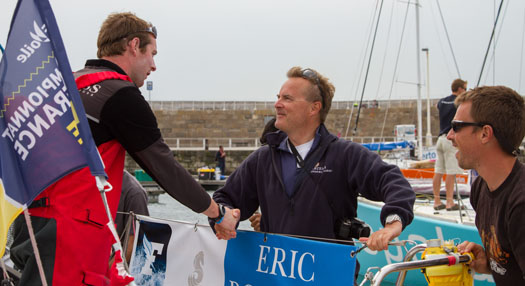
Marcus Hutchinson greets David Kenefick at the end of leg two. Photo: Brian Carlin
On the last morning he had positioned himself in the middle of the lateral group with serious Rookie opposition on the extremes on both sides. Jackson Bouttell and Claire Pruvot were offshore and Simon Troel was inshore. Without being sure as to exactly how is was going to pan out David was one of the last to escape offshore to the new Easterly wind and although he lost contact with Claire he managed to come home second in the Rookie division just ahead of Jackson and several hours ahead of Simon Troel. David finished 18th out of 41, definitely in the first half of the fleet and a really positive result. He slept a lot, he learnt a lot and he managed himself and the boat well.
Five of the six strong Artemis group, of which David is a part for this race, finished in the top 20 which is a great result for all, but until the final finish line in Dieppe it means nothing at all as the race is on, as much ashore during these extremely short stopovers, as afloat, and what lies in store over the next two legs is far from clear.
"Knowing you have made an error like that and having to live with it for the next two days is really harsh. This is a cruel sport".
The race for the skippers ashore is to sleep and eat and rehydrate, and sleep some more and eat some more and then start thinking about the weather for Leg 3. Those that finish the previous leg early have more time in bed. Those that stay on the course a little longer have the double whammy of realizing this and when you sail into the harbour at the end of a leg and realize that most of the fleet is already tied up and their skippers are resting it doesn't help. This was the case for Ed Hill who finished in the dark more than six hours behind the leaders. A small error of judgement compounded into a massive deficit for poor Ed as he rounded Cape Finisterre much further offshore than what was ultimately necessary meant that the rest of the fleet slipped away into a new breeze. Knowing you have made an error like that and having to live with it for the next two days is really harsh. This is a cruel sport. Ed will bounce back and come out fighting for Leg 3 in two days.
Probably the best thing to start coming out of the young sailors mouths in the moments after docking and as they all sit down around a bowl of hot soup with their fellow competitors and share stories, is how much and when the Artemis skippers slept, what they are eating and how they plan their decision-making. There was plenty of warning about the complexity of this past leg and most of the skippers racked up a lot of sleep early in the leg and even on the last night knowing that there would be important strategic decisions to be made on the last day. Some of the skippers are now realizing that the autopilot is an amazing tool and can often do a far better job than the skipper steering the boat in relatively stable conditions when the night is dark and the eyes are tired.
Food choices to take offshore are now tending more and more towards a really balanced diet as opposed to the sugary things. Gone are the cans of Red Bull and Coke and sports bars. In have come the small tins of tuna salads, fresh pasta and soups. Its been a long road and in spite of pleading with skippers to take diet seriously sometimes it is best for people to work it out for themselves the hard way rather than ignoring the constant nagging from those of us that apparently know better!
#fullirish – So they are off on Leg Two, a shortened version of the original programme because of extremely light conditions forecast the leg is just 300 nautical miles long. The course is now very simple, sail North from Porto until you reach the corner of Spain and then turn right and sail East along the North Coast to Gijon. If only it was that simple. There are two complications, the first is very light winds and the second is the topography of the coast.
As the fleet leaves Porto in a SW wind heading North at a paltry five knots a simple front will pass over head and swing the wind round to the North West. On the back ide the wind will be more stable and a little bit fresher but nothing dramatic. The objective at the beginning of the race is therefore to cross the front as soon as possible and get to the other side first. The options that the leaders of the fleet have taken to do this aren't the same, this is a race and it will be interesting to see how this works out. Some have decided to foot off with spinnakers set to get as far North as possible before being headed and needing to tack, others will sail as high as possible until the shift comes against them and they can tack and get to the left more quickly.
Moving forwards a few more hours through the night the fleet will be sailing upwind tacking from time to time to stay to the West of the front but not going too far west as behind the front is a ridge of high pressure and the wind will start free the fleet again as it lifts them on port tack with spinnakers again appearing.
But all of this is going to be slow and require painful amounts of concentration from the 41 skippers. Around the top of Finisterre there will probably again be fog and depending on how quickly the westerly wind through the ridge appears will dictate how far offshore the smart money will sail as they head East along the North Spanish coast. Close to the shore and the high ground associated with North Spain there will be no wind and really unpredictable conditions.
The leg is likely to take three days so expect to see them sometime on Tuesday midday in the Spanish port of Gijon. The sleep programme is going to be extremely important and really difficult to know when to push on steering and when to get your head down. Those that are able to keep themselves motivated in the head-bursting fatigue stakes will be able to maybe make the killer decisions later in the race when others are struggling. Another classic Figaro leg is underway.
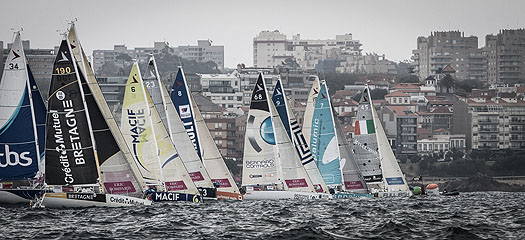
David made a cracking start at the pin end of the line as the photograph above proves. Regrettably half way up the beat he was relegated to the second half of the fleet as the pace around him, the timing and execution of light air manoeures let him down. David is in the pack, and needs to stay with other boats to be able to judge his speed and make adjustments when necessary.
Whereas Leg One was physical and then seriously light at the finish this leg will be light all the time and always mental and rarely physical. The concentration levels will need to rise and fall in parallel with the stretches of the course that are either difficult or straight forward.
Show your support for David on his Facebook page on Sunday, it will be his 22nd birthday.
David Kenefick Blog #4 – 'I Made a Mistake, the Biggest of My Figaro Race and it Cost Me'
Irish Figaro race rookie David Kenefick describes his first leg in which he finished 33rd from 41 starters
The first night I was exhausted. I guess it was the week-long build-up in Bordeaux, all the stress of moving from Bordeaux to Pauillac - the crowds, my family, media engagements, sponsors - all part of it but nevertheless exhausting. I knew I had to get a lot of sleep in early in this race as we wouldn't be doing much at the end.
But I wasn't in a great space off the start line and I took my time to get going. I actually hit something that wasn't on a chart in the river estuary. We'll get the boat out tomorrow and fix up the keel.
So bad start, tricky exit, hit something that wasn't on the chart in the river, then I waited and waited for the opportunity that I knew would be coming at Cape Finisterre, I got it and it worked out great. But then I made a mistake, the biggest mistake of my race and it cost me. It's a shame because I waited two days for my opportunity and when it came, I blew it.
The strategy for the race was: to get safely out of the Gironde in one piece without too much of a deficit, to sail extremely fast across the
Bay of Biscay to the point where a gybe in the freeing wind would line you up for the right trajectory around Cape Finisterre, to be ready for the big breeze that would hit the fleet at that point but to make sure not to cut the corner too tight and run out of wind in the lee. On top of that the small depression centred around the corner would mean a total shut down of wind and it would probably pay to be further west. Don't get trapped. The last part of the race sailed down the Portuguese coast would be sailed in light winds. The key message was that regardless of what happened inshore and how attractive it might look, eventually the offshore route would pay.
We had 35 to 40 knots of breeze off Finisterre. My mistake was I didn't sleep when I had the opportunity, I was too focused on keeping it together through the night in that breeze. I had never sailed in conditions like that for such a long time before. And my mistake was accumulating too much fatigue that would have to be dispensed with later on, and I couldn't afford to later on as that was the most important part of the race. I then started going for naps and I obviously went for one that was a bit too long. Probably woke up two hours later. I'm not sure what happened to my alarm it is usually really good at waking me up eight minutes after I've set it. I'm fresh as a daisy now!!!
I was very lucky but I was stupid. I'm not sure what happened, whether I just sat down for a few minutes or whether I'd planned to do it but I must have slept for two hours straight. When I woke up it was dark, I couldn't see anyone around me except fishing boats. I was completely disorientated.
"I couldn't see anyone around me except fishing boats. I was completely disorientated"
By now I was stuck in a hole in no wind. The bunch I was with got away from me at this point and of course I never saw them again. I believe Morgan Lagraviere, who was just behind me at the time finished 12th. I wouldn't have minded that!
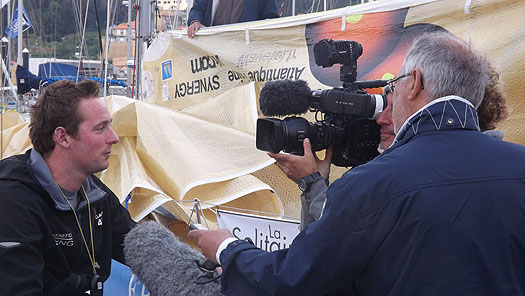
David Kenefick meets the press after leg one
Anyway the important things are that the man and the boat are both in one piece. Everything worked fine. I'm really pleased to be here and fresher than a lot of others I can see around me so hopefully that means I'll do a good job on the next leg. Interestingly my buddy Jackson Bouttell who won the Rookie prize for this leg pointed out to me today that the three events we have already done this year plus the leg we have just finished are less in combined distance than what we have still to sail over the next three legs. I might need to avoid thinking about that too much!!!
Leg Two from Porto to Gijon (452 nautical miles) starts on Saturday 8th June.
#fullirish – We are 45 hours into the first leg and the fleet are about eight hours ahead of the initial routeing calculations writes David Kenefick team manager Marcus Hutchinson. The fleet of 41 Figaros has been enjoying great sailing pretty much since the left the Gironde Estuary on Sunday night when the set their spinnakers. The wind has slowly swung around to the East as the High Pressure zone has moved North and they find themselves on the South side of the cemtre. As can be seen from the tracker on the official website the fleet started to think about gybing yesterday afternoon/evening and line themselves up for the approach to the North West tip of Spain. The wind freshened dramatically through the night as the isobars between a small depression just around the corner off the West coast of Spain and the bottom of the High squeezed it all together. The fleet have been enjoying some high speed downwind sailing in 30/35 knots of wind and from the reports from the race course it would appear that there have been quite a few broaches and spinnakers bursts. They also had a fairly big fishing fleet to deal with too!
The leaders have kept good pace but most significantly have had a long term view about tackling this depression mentioned earlier as they start to turn the corner. Mich Desjoyeaux has opted for a more Northerly and offshore route around the outside and will likely extend further his lead. Anyone who stays offshore will gain over the next few hours.
Further back down the fleet we find that the Rookies are having a tough time and not surprisingly many of them have gravitated towards their fellow rookie competitors to be able to judge their performance. Performance is not just about going fast now. The sailors are all into their third day and will certainly be tired and know that they have another 24 hours at least left to sail. Performance is going to be about being sufficiently sharp to make the right decisions with regard to timing for their gybe South and quite how far extra to sail to get around the top of Spain.
Young David Kenefick may have been stacking in a lot of sleep yesterday in anticipation of the two days still ahead of him as he frequently moved from one side of the fleet to the other side having initially been in the middle then heading out on his own to the South before later yesterday evening re-crossing behind the fleet again. The reality is that he would appear to be sailing at top speed. Although the rankings show him in 35 place at 10:00 this morning - the ranking during the race is a simple calculation of distance as the crow flies around the various headlands to the finish. The fleet is sailing near a big corner and the quickest route is going to be over a longer distance which is why many of the boats currently ranked closer to the finish and 'ahead' of David are going to drop in behind him later on. Currently David is probably in 30th position, surrounded by Claire Pruvot and Jackson Bouttell, the latter we have heard has blown out his big spinnaker and will suffer in the lighter winds expected later.
Eta in Porto is still for tomorrow Wednesday night, the first boats are currently about 10 hours ahead of schedule.
Keep up to date by checking the official website in English lasolitaire.com/en and the on the events excellent race tracker.
La solitaire du Figaro - the big race - started today at 13:00 and for young David Kenefick it was indeed a big occasion. 10,000s of people had come to see the 41 solo sailors head off on the first leg which takes the fleet down the Gironde estuary from Pauillac and out across the Bay of Biscay to Cape Finisterre and down Spanish and Portuguese coast to Porto, 535 miles. After weeks of horrible weather summer switched on this morning, the temperatures soared into the mid-20s and the sun burnt everyone who ventured outside.
The Gironde Estuary is a bit like the Solent only three times as long. The race start was set for just before high tide to allow the fleet to start and do some local round the cans racing in slack water for the crowds, sponsors and live TV show, before heading down the river with the start of the ebb. But as everyone knows the tide never turns evenly in a river or narrow arm of the sea. It always turns on the edges first and it was to the edges that the fleet split for the first mile and a half beat upwind against the tide.
David had a terrible start and was amongst the backmarkers off the line, which put him in a poor position for the first beat as he tried to hang in. He was amongst good company though with some big scalps near him. The problem is there are big scalps all over the fleet. This is a race of attrition and just finishing every leg is a major sailing and seamanship achievement. The goal for David now is to settle himself down and stay in a low risk mode for the rest of the Gironde Estuary and once out in the Atlantic with the kite up start to get rested and get into a routine that will see him lucid enough to make the right decisions at the right time further down the track.
The first casualty of this rather unusual early part of the course is a fellow rookie competitor and perhaps favourite rookie Frenchman Simon Troel. He was having a great race and was in 12th place but has gone aground on a mud bank and will have to wait out the tide before he can get off. That will cost him the race as this race is ranked by cumulative elapsed time, not points and a 12 hour deficit this early in the race will be hard to recover from.
The fleet will see spinnakers set as the pass the Pointe de Grave and head out into the Bay of Biscay. They are expected to have downwind sailing all the way to Cape Finisterre in a building breeze before a complex low slows the game down as they head south towards the Portuguese finish port of Porto. They are expected to finish sometime late on Wednesday night or early on Thursday morning this week.
We'll keep regular updates going on www.afloat.ie page over the next three weeks.
#fullirish – With five days to go to the start of Leg One of the 2013 Solitaire du Figaro Ireland's David Kenefick reports in from Bordeaux, the start port.
There is so much to do during this week before the start of the Figaro. I hadn't realised how intense it would be in spite of being told over and over again by those around me. I guess that is experience. Interestingly many of the French skippers aren't even in town for the first few days of the week, leaving all the formalities to their shore crew. The Rookies are all here, getting it together, and I'm one of them and its great.
So safety checks, measurement checks, sealing of heavy weights in the boat, radio checks, AIS checks, nav equipment checks, and that's just the organisers and scrutineers. Its all for a reason, our equipment has to work and there would be remorse and liability if anything happened and in hindsight things were not done to best practice Protocols.
'I won't be drinking much wine but it will be interesting to see how these vineyards work'
I have sponsor obligations too. This could be seen to be inconvenient but that would be to miss the point. Our sponsors are amongst the reasons why we have been able to get to this stage and this is their time as much as ours to get the return, sell the products and be talked about. One of our sponsors is Patton Watches and I proudly wear one on my wrist. They have a stand in the village and everyday one of the six non-French skippers spends some time with the staff there signing posters and postcards of us racing our boats. They have made a significant contribution to our logistics pool for which we are all extremely grateful. And it gets better. Which ever of the six of us does the best in the event on points wins their top of the range sailing watch, a rather smart analogue chronograph produced in association with Harken.
Last week my team secured some more sponsorship for me and we will announce this later this week. It is very exciting to now be able to partially justify my existence commercially and this is the best possible training ground for me to learn how it works in the big bad world of professional/commercial sailing ventures.

David (right) Signs photographs of Ireland's 'Full Irish' campaign in Bordeaux. Photo: Brian Carlin
We are in Bordeaux and tomorrow night all 41 skippers have been invited to dinner at one of the famous wine Chateaux. It is Chateau Pichon and the guy who runs it, Yannick Evenou, and invited us is himself an ex-Figaro sailor from the 1990s.
I won't be drinking much wine but it will be interesting to see how these vineyards work.
More soon



























